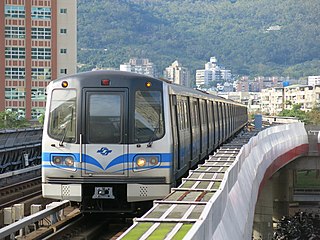
Rail transport is a means of transport that transfers passengers and goods on wheeled vehicles running on rails, which are incorporated in tracks. In contrast to road transport, where the vehicles run on a prepared flat surface, rail vehicles are directionally guided by the tracks on which they run. Tracks usually consist of steel rails.

High Speed 1 (HS1), legally the Channel Tunnel Rail Link (CTRL), is a 109.9-kilometre (68.3-mile) high-speed railway linking London with the Channel Tunnel.
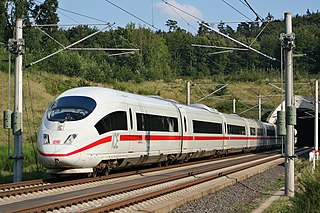
Intercity Express is a high-speed rail system in Germany. It also serves destinations in Austria, France, Belgium, Switzerland and the Netherlands as part of cross-border services. It is the flagship of the German state railway, Deutsche Bahn. ICE fares are fixed for station-to-station connections, on the grounds that the trains have a higher level of comfort. Travelling at speeds up to 320 km/h (200 mph), they are aimed at business travellers and long-distance commuters and marketed by Deutsche Bahn as an alternative to flights.
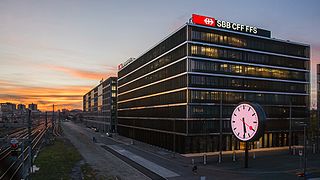
Swiss Federal Railways is the national railway company of Switzerland. It is usually referred to by the initials of its three official names – defined by federal law SR/RS 742.31 (SBBG/LCFF/LFFS) Art. 2 §1 – in German, French, and Italian, either as SBB CFF FFS, or used separately. The official English abbreviation is "SBB". While the official Romansh name, Viafiers federalas svizras (VFF) is used in federal documents and laws and Romansh-language media, it is not used by the SBB.
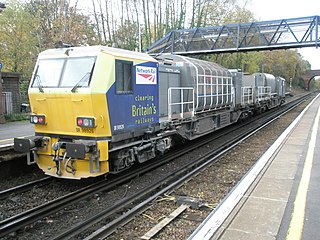
The Multiple-purpose Vehicle or MPV is a purpose-built departmental derivative of a diesel multiple unit. Twenty-five two-car units were ordered by Railtrack to enable it to replace its varied collection of ageing departmental vehicles, many of which were converted from redundant passenger stock.

The British Rail Class 92 is a dual-voltage electric locomotive, which can run on 25 kV AC from overhead wires or 750 V DC from a third rail. It was designed specifically to operate services through the Channel Tunnel between Great Britain and France. Eurotunnel indicates the Class 92 locomotive as the reference for other locomotives which railway undertakings might want to get certified for usage in the Channel tunnel.

The British Rail Class 325 is an electric multiple unit (EMU) train owned by and operated for the Royal Mail to carry bulk mail. The class consists of four-car sets with dual-voltage 25 kV (AC) and 750 V (DC) power. While the Class 325 cabs bear a resemblance to the Networker family of DMUs and EMUs, the Class 325 is based on the Class 319.
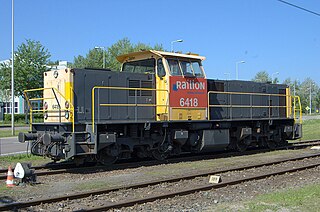
The NS Class 6400 is a type of 4 axle diesel-electric freight locomotive. 120 were built by MaK and ABB between 1988 and 1994 for Nederlandse Spoorwegen.

Alstom Traxx is a modular product platform of mainline diesel-electric and electric locomotives produced originally by Bombardier Transportation and later Alstom, which was built in both freight and passenger variants. The first version was a dual-voltage AC locomotive built for German railways from the year 2000. Later types included DC versions, as well as quadruple-voltage machines, able to operate on most European electrification schemes: 1.5/3.0 kV DC and 15/25 kV AC. The family was expanded in 2006 to include diesel-powered versions. Elements common to all variants include steel bodyshells, two bogies with two powered axles each, three-phase asynchronous induction motors, cooling exhausts on the roof edges, and wheel disc brakes.

SBB Cargo is a subsidiary of Swiss Federal Railways (SBB) specialising in railfreight and is operated as the Freight division. Swiss Federal Railways is a former state-owned and -controlled company that was transformed in 1999 into a joint-stock company under special legislation following the first Swiss railway reform and divided up into three independent divisions: Passenger, Freight and Infrastructure. The headquarters of Swiss Federal Railways SBB Cargo AG, the Freight division's official designation, are in Olten. In 2013, SBB Cargo had 3,061 employees and achieved consolidated sales of CHF 953 million. In Switzerland, SBB Cargo is the market leader in rail freight, transporting over 175,000 tons of goods every day. This corresponds to the weight of 425 fully loaded jumbo jets.
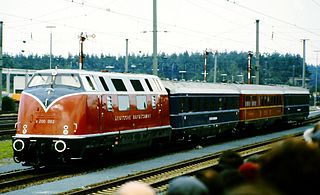
DB Class V 200 was the first series production diesel-hydraulic express locomotive of the German Deutsche Bundesbahn and – as Am 4/4 – of the SBB-CFF-FFS in Switzerland.

The Scharfenberg coupler is a commonly used type of fully automatic railway coupling.

The EuroSprinter family of electric locomotives is a modular concept of locomotives for the European market built by Siemens Mobility. The internal Siemens product name is ES 64, with ES for EuroSprinter and the number 64 indicating the 6,400 kW power at rail.
Windhoff is a German manufacturer of specialised railways rolling stock, and heavy industrial plant. The company was founded in 1889.

Goods wagons or freight wagons, also known as goods carriages, goods trucks, freight carriages or freight trucks, are unpowered railway vehicles that are used for the transportation of cargo. A variety of wagon types are in use to handle different types of goods, but all goods wagons in a regional network typically have standardized couplers and other fittings, such as hoses for air brakes, allowing different wagon types to be assembled into trains. For tracking and identification purposes, goods wagons are generally assigned a unique identifier, typically a UIC wagon number, or in North America, a company reporting mark plus a company specific serial number.

A car shuttle train, or (sometimes) car-carrying train, is a shuttle train used to transport accompanied cars (automobiles), and usually also bicycles and other types of road vehicles, for a relatively short distance.
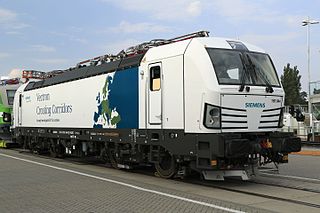
The Vectron is a locomotive series made by Siemens Mobility, introduced at the 2010 InnoTrans trade fair in four prototype versions: diesel, multi-system, and both AC and DC electric power. The diesel version has been replaced in 2018 by a dual mode locomotive which is powered by electricity on electrified sections of the track and can be switched to diesel mode on non-electrified sections. The Vectron series is reconfigurable and modular, with a Bo'Bo' wheel arrangement, and is intended as the successor to the EuroSprinter family of locomotives. A more affordable, basic version called Smartron was introduced in 2018.
SBB Cargo International is a rail transport business founded in 2010 as a joint venture between SBB Cargo and Hupac. It was created to engage in the carriage of international rail freight across the European market.
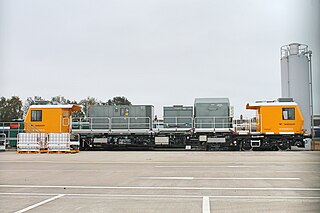
The Multi-purpose vehicle is a purpose built departmental derivative of a diesel multiple unit constructed for use as a rail adhesion vehicle by NI Railways in Northern Ireland.


















